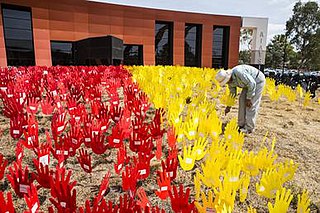Country
The traditional tribal lands of the Goeng, according to Norman Tindale, stretched over an estimated 1,200 square miles (3,100 km2), running from the southern end of Port Curtis to near mouth of Baffle Creek. Their inland extension went as far as the headwaters of the Kolan River, and took in the ManyPeaks Range. Their land also included Lowmead and one of their borders touched Miriam Vale.

Norman Barnett Tindale AO was an Australian anthropologist, archaeologist, entomologist and ethnologist.

Baffle Creek is a locality in the Gladstone Region, Queensland, Australia. In the 2011 census, the population of Baffle Creek was too low to separately report and was aggregated with the neighbouring locality of Deepwater which had a reported population of 548 people. The neighbourhood of Wartburg is within the locality.

The Kolan River is a river located in Central Queensland, Australia.
This page is based on this
Wikipedia article Text is available under the
CC BY-SA 4.0 license; additional terms may apply.
Images, videos and audio are available under their respective licenses.
The Goreng Goreng are an indigenous people of Queensland and also a language group. The Goreng Goreng area is between Baffle Creek to Agnes Water in the north, extending westerly as far as Kroombit Tops.

The Barapa Barapa people are an indigenous Australian people whose territory covered parts of southern New South Wales and northern Victoria. They had close connections with the Wemba-Wemba.
The Tulua were an indigenous Australian tribe of Queensland.
The Bibulman (Pibelmen) were an indigenous Australian people of the southwestern region of Western Australia
The Pirlatapa are an indigenous people of South Australia.
The Yawarrawarrka were an in indigenous people of South Australia.
The Maikathari (Mayi-Thakurti) were an indigenous Australian people of the state of Queensland.
The Maijabi (Mayi-Yapi) were an indigenous Australian people of the state of Queensland.
The Kunandaburi or Karendala (Garandala) were an indigenous Australian people of the state of Queensland.
The Gugu Rarmul were an indigenous Australian people of the state of Queensland, one of several whose speech was called Gugu Yawa.
Yadaneru, also written Jeteneru, refers to a tribe at one time thought to have existed in the Cape York Peninsula of northern Queensland.
The Wikatinda were an indigenous Australian people of the Cape York Peninsula of northern Queensland. They were one of the Wik peoples, but their language is unattested.
The Julaolinja were an indigenous Australian people of the state of Queensland.
The Kunggara, also known as Kuritjara, are an indigenous Australian people of the southern Cape York Peninsula in Queensland.
The Malintji were an indigenous Australian people of the state of Queensland.
The Kaiabara were an indigenous Australian people of the state of Queensland. Rasther than an independent tribe, they may have been a horde of the Gubbi Gubbi.
The Nggamadi were an indigenous Australian people of the Cape York Peninsula of northern Queensland.
The Kokomini (Gugumini) are reported to have been an indigenous Australian people of the state of Queensland, though some indications suggest the term may refer to a loose confederation of tribal groups.
The Nguri were an indigenous Australian people of the state of Queensland.
The Kula, also known as the Kurnu, were an indigenous Australian people of the state of New South Wales.







